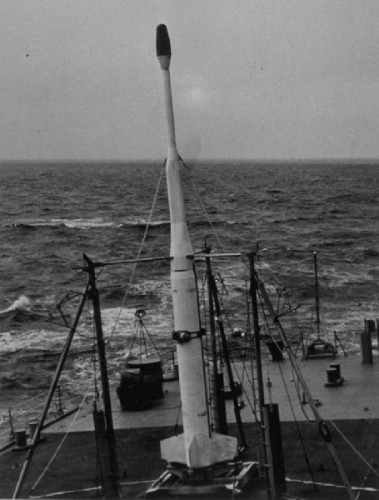|
|
|
|
October 13, 1947 ..
Project Cirrus was the first attempt to modify a hurricane. It was a collaboration of the United States Weather Bureau, the US Army Signal Corps, the Office of Naval Research, and the US Air Force. After several preparations, and initial skepticism by government scientists, the first attempt to modify a hurricane began on October 13, 1947 on a hurricane that was heading west to east and out to sea. An airplane flew along the rainbands of the hurricane, and dropped nearly 80 pounds of crushed dry ice into the clouds. The crew reported "Pronounced modification of the cloud deck seeded". It is not known if that was due to the seeding. Next, the hurricane changed direction and made landfall near Savannah, Georgia. The public blamed the seeding, and Irving Langmuir claimed that the reversal had been caused by human intervention. Cirrus was cancelled. Lawsuits were threatened. Only the fact that a system in the 1906 season had taken a similar path, as well as evidence showing that the storm had already begun to turn when seeding began, ended the litigation. This disaster set back the cause of seeding hurricanes for eleven years. SOURCE: Wikipedia Project Cirrus |
|
| October 15, 1947
1947 oct 15th 85mph gusts 95mph 1 killed,press 28.76. This hurricane was cloud seeded, A-B-17 bomber dropped 180lbs of dry ice into the Hurricane off the coast of S Carolina and many blamed that for the change in direction as she moved back west and hit. A 12 ft storm surge reported here with mass evacuations keeping casualties at a minimum. |
|
|
1958 - South Atlantic ..
Operation Argus
was the only clandestine test series in the 17 year history of atmospheric
testing. It was secretly conducted in the South Atlantic, 1100 miles southwest
of Capetown, South Africa. Argus consisted of three very high altitude
test shots of the W-25 warhead to investigate the effects of nuclear explosions
outside of the atmosphere - how the charged particles and radioactive isotopes
released would interact with the Earth's magnetic field which could potentially
interfere with radar tracking, communications, and the electronics of satellites
and ballistic missiles.
In a way, these tests could be considered a logical extension of the high altitude shots conducted within the atmosphere in Hardtack I which detonated warheads at 85,250 feet (a 1.7 kt W-25 in the Yucca shot), 141,000 feet (a 3.8 Mt W-39 in the Orange shot), and 252,000 feet (also a 3.8 Mt W-39 in the Teak shot). Argus pushed nuclear tests still higher with effects tests at 100 miles (528,000 feet), 182 miles (961,000 feet), and 466 miles (2,460,000 feet). The motivation for this secret series was a theory developed by the brilliant but eccentric physicist Nicholas Christofilos at Lawrence Radiation Laboratory (LRL). He had predicted that military significant effects would be produced by injecting charged particles from nuclear explosions into near space to create artificial Van Allen belts. This series sought to prove (or disprove) his theory by actually creating such a belt. Operation Argus has been termed the "world's largest scientifc experiment" encompassing as it did the space surrounding the entire Earth. The tests essentially confirmed his predictions. All three shots were launched by a specially modified Lockheed X-17A three-stage missile fired from the USS Norton Sound (AVM 1) which was operating as part of the 9 ship Top Secret Task Force 88. The W-25 warhead produced yields of 1.7 kt, as in previous tests. The plutonium implosion W-25 warhead was developed for the unguided air-to-air rocket Genie, and was exceptionally light for the time 218 lb (98.9 kg), dimensions were 17.4 inches (width) and 25.8 inches (length). It had previously been fired three times, so its yield and reliability was well established. The X-17A was 42 feet 10 inches long with the Argus payload, and had a diameter of 91.12 Inches. To investigate the effect of trapped radiation in the Earth's magnetic field it was important pick a test site where the magnetic field configuration could trap and hold charged particles efficiently - this dictated test between 35 and 55 degree (either north or south of the equator). The altitude limit of the available missile dictated a southern hemisphere test since the fact that the global magnetic field is centered about 200 miles off-center from the Earth's geometric center brings the stable trapping region 400 miles closer to the surface there. Although the W-25 was a LASL warhead design, Argus was actually conducted by LRL. The New York Times broke the story of this test series on 19 March 1959. SOURCE: http://nuclearweaponarchive.org/Usa/Tests/Argus.html |
|
| FAIR USE NOTICE: This page contains copyrighted material the use of which has not been specifically authorized by the copyright owner. Pegasus Research Consortium distributes this material without profit to those who have expressed a prior interest in receiving the included information for research and educational purposes. We believe this constitutes a fair use of any such copyrighted material as provided for in 17 U.S.C § 107. If you wish to use copyrighted material from this site for purposes of your own that go beyond fair use, you must obtain permission from the copyright owner. | |
|
|


